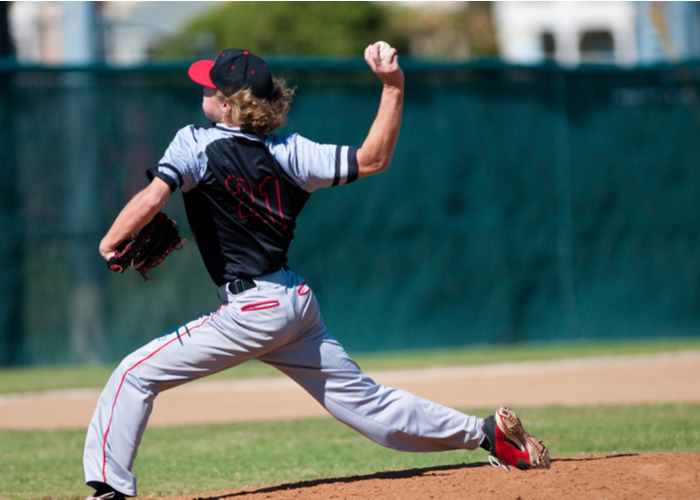What are throwing injuries in the shoulder?
When a baseball pitcher chooses their pitch or a football quarterback receives a snap, a series of five stages subsequently follows in the throwing shoulder: wind-up, early cocking, late cocking, acceleration, and follow-through. Because these athletes generally throw an object at such a high rate of speed, a large amount of stress is placed on the shoulder structures, especially during late cocking and follow-through, to ensure the humeral head (upper arm bone) is secured within the glenoid socket of the scapula (shoulder blade).

This stress from repetitive high-velocity throwing can weaken the tissues of the shoulder joint leading to the other structures compensating for the stress load and ultimately resulting in throwing shoulder injuries. Athletes that perform repetitive throwing motions, like those seen in volleyball, football, baseball, cricket and basketball, have the greatest risk of sustaining a throwing shoulder injury. Dr. Ronak Mukesh Patel, orthopedic shoulder specialist serving patients in Sugar Land, Pearland, and the Houston, Texas area, has the knowledge and understanding, as well as substantial experience, in treating throwing shoulder injuries.
What are the symptoms of throwing shoulder injuries?
The symptoms reported from a throwing shoulder injury vary depending on the type of injury sustained by the throwing shoulder joint. One of the most common complaints of a throwing shoulder injury is pain with activity that worsens with lowering or lifting the affected arm. Other symptoms of a throwing shoulder injury can include:
- Decreased range of motion
- Decreased throwing speed
- Shoulder weakness
- Pain at night, especially with laying on the affected shoulder
- Shoulder stiffness
- A grinding or popping sensation within the shoulder joint
How are throwing shoulder injuries diagnosed?
Dr. Patel will obtain a detailed medical history to include the initial injury or any prior shoulder conditions. A physical examination will then be performed to assess the affected shoulder’s strength, stability, and range of motion as well as the level of pain. Diagnostic testing, such as x-rays or magnetic resonance imaging (MRI), may be conducted to confirm a throwing shoulder injury diagnosis and identify any damage to the other structures within the shoulder joint.
What is the treatment for a throwing shoulder injury?
Non-surgical treatment:
The initial treatment for a throwing shoulder injury is the implementation of non-surgical therapies. Limiting the shoulder activity that precipitated this injury can prevent any further damage to the shoulder joint. Ice application and non-steroidal anti-inflammatory medications (NSAIDs) can minimize the pain and swelling associated with this condition. If the pain and/or inflammation still persists with oral medications, a corticosteroid injection can be directly administered into the shoulder joint. When appropriate, strengthening the muscles that surround the shoulder joint and improving shoulder range of motion through a physical therapy program is highly encouraged.
Surgical treatment:
Dr. Patel will evaluate several factors, such as the patient’s age, activity level, medical history, and desired outcome, to determine if surgical intervention is an appropriate treatment. Throwing shoulder injuries can be successfully repaired through 2 surgical approaches:
- Arthroscopy: This is the preferred surgical repair option by patients and surgeons alike for treating throwing shoulder injuries. A small camera (arthroscope) is introduced into the shoulder joint in this minimally invasive surgical procedure. The images from the arthroscope are relayed onto a screen where Dr. Patel can methodically examine the structures of the shoulder joint. Specialized surgical instruments are then utilized to repair any damaged tissues including the shoulder ligaments, rotator cuff, or labrum.
- Open surgery: Occasionally a slightly larger incision is necessary for Dr. Patel to visualize the entire shoulder joint while completing the necessary revisions. Dr. Patel prefers this surgical method over an arthroscopic repair for patients with extensive soft-tissue damage to multiple structures within the shoulder joint.
Throwing Shoulder Injury Specialist

Do you participate in sports that involve frequent throwing such as baseball or football? If so, you may be at an increase risk of developing a shoulder injury due to the stress placed on the shoulder while throwing. Complex shoulder specialist, Doctor Ronak Mukesh Patel, provides diagnosis and personalized treatment plants for patients in Houston, Sugar Land, and Pearland, TX who are experiencing shoulder pain and weakness. Contact Dr. Patel’s team today!


